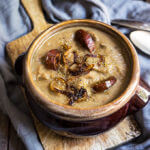Crispy caramelized crepes – these classic French crepes, crisped up with a thin layer of buttery, salted caramel on one side, are simply too good to miss.

This recipe is so simple, yet it feels and tastes quite special. As I’m writing this, I realize that for many people, making crepes may not sound like the easiest thing to make. If you are one of them, please read on. Hopefully I’ll change your mind.
Growing up, I ate crepes almost every weekend for breakfast, and learned how to make them at an early age. In fact, one of the first things I taught my daughters how to make was crepes, and if a 10-year old can manage pretty well, you can too. Not only I prefer the taste of crepes over pancakes, but I enjoy the process of making them much more. Something about the repetitive rhythm of swirling the batter, flipping the crepe, buttering the pan…feels almost meditative for me, and way more satisfying.

You know how you can tell you’ve mastered the art of crepe making? When you can flip the crepe in the air, and catch it in the pan with no help from hands or utensils :)) But for the purpose of this post, we’ll stick to basics. Plus, the acrobatics really don’t contribute to much, except bragging rights!
In this post, I’ll share my go-to basic crepe recipe, and also explain how to take an ordinary crepe, and in a minute, turn it into a special, gourmet breakfast. A thin layer of crunchy, salted, buttery caramel, is all it takes to elevate the crepe to a whole new level.

But first, let’s talk about making basic crepes.
How to make the perfect, no-fuss crepe:
Batter rest: a myth?
I know that most crepe recipe instructions call for the batter to rest at least 30 minutes. The reason for this is so that the gluten develops, and supposedly make the crepes more tender. Now, while I don’t contest the science behind this, I cannot attest for the wisdom of this advise either because I’ve never done it. First of all, our moms didn’t do that, and didn’t teach us that little trick, and moms know best, right?! But I can tell you this – I don’t know how a crepe can taste much better than it does, when I make it my way :), and I can guarantee you that the tenderness of the crepes is not affected at all! In fact, if I use 1 more egg, or if I replace the milk with a mix of yogurt and water, the crepes get tenderer. So feel free to rest the batter if you have the time, but don’t fret over this step, because the crepes will taste just great even if you don’t.
Batter consistency:
Batter consistency is probably more important to talk about. It should be as thick as heavy cream. After so many years of making crepes, I never measure my flour, because I can tell, just by stirring the batter, if it’s the right consistency. Occasionally though, I may have to adjust it after making my first couple of crepes. If the batter is thicker, it would be hard to swirl and spread over the pan. If it’s too thin, the crepe may lack enough substance. The good news is, both these problems are easily solved by adding a little more milk, or flour. The recipe I’ve given you should result in the right batter consistency, and yet, if your eggs are slightly bigger or smaller, it may need a bit of adjusting.
How can you tell if your batter is right? By making at least two crepes. The first one will always be a little off, so make a second one, and see how the batter feels – if it feels heavy in the pan, and doesn’t easily spread out to the edges, you need to thin it out a little. Add a few tablespoons of milk, and stir well, before proceeding. If the batter feels too light, and watery, you need to add 1-2 tablespoons of flour.
Heat and equipment:
As mentioned above, the first crepe is almost always a failure (as far as presentation mostly), due to the heat of your pan, being either too low, or too high. If it’s not hot enough, the batter may not spread out so smoothly, and it will be uneven in thickness, and shape. If the pan is too hot, it will result in a burnt crepe. I always turn the heat on high until it heats up, then reduce to medium, and start cooking.
For best results, you need a non-stick crepe pan, with shallow depth, like this one. Use a thin spatula that can easily slide underneath the crepe, and flip it. Usually when the edges of the crepe begin to brown slightly, the crepe is ready to be flipped. If you cannot slide the spatula all the way to the middle, then the crepe needs another 15-20 seconds before it’s ready for cooking on the other side. Most of the cooking happens on the first side, and it usually takes about 15-20 seconds of cooking on the second side. As you flip the crepe, the cooked side will have a few brown spots. If they are almost black, it may be a sign that your heat is still too high. You want to see lightly brown spots.
You want to pour the batter in the middle of the pan, holding it with one hand off the heat, and quickly swirl so it spreads out all the way to the edges. If the pan is hot enough, the moment the batter touches the surface it will start cooking, so you want to do it relatively fast.
Flavor:
The best-tasting crepe is the one taken straight our of the pan, thin and tender, with buttery flesh and slightly crispy edges. I like to butter each crepe, as it comes out, while it’s still hot, by quickly rubbing the butter stick all over. I also like to butter the pan, before pouring the batter, but you can use a tiny bit of coconut oil, or other oil of choice as well. You only need about 1/2 tsp of fat per crepe.
If you don’t have hungry kids, lined up, holding their empty plates, waiting for the next ready crepe, and if you’re planning on serving them later, the best way to preserve them is to cover the ready ones with a lid, while you make the rest. You may loose the crispy edges, but the crepes will be warm, and soft.
This recipe is suitable for both savory and sweet fillings. If you are only going to serve the crepes with sweet, you may add a dash of vanilla or a pinch of cinnamon to the batter.

Crepes are so versatile! You can stuff them with savory or sweet fillings, you can stuff and bake them smothered in sauces, like enchiladas, you can fold them, or roll them, and it will all result in a slightly different experience! The recipe I’m sharing with you today is different – instead of using a filling, it adds flavor by adding a thin layer of crispy, salted caramel to the crepe.
The idea came to me long ago, when visiting my friend in France. She took me to a creperie, and even though I don’t remember what crepes I ordered I’m certain I didn’t go for the ones with butter and sugar. I remember my friend telling me, that the French prefer to eat the crepes simply like that – with a layer of salted butter, sprinkled with regular sugar. That sounded pretty simplistic to me, and not quite appealing at the time. But as I dwelled on that curiosity, it struck me how genius it is – after all, some of the best flavor combinations are a blend of sweet and salty. I wanted to take this idea one step further though, and instead of using plain old raw sugar, I caramelized it, and added flakes of coarse sea salt to boost the flavor even more.
It’s important that the caramel layer is very thin, so it doesn’t overpower the crepe. As it cools off, it actually turns slightly crunchy. You really need about a 1 1/2 – 2 teaspoons of sugar per crepe, and no other toppings, so you can taste the salted buttery caramel, and the delicate flesh of the crepe.
This recipe makes enough for two hungry kids. For four people, I suggest you double it. If you have any leftover crepes, they are a great replacement for tortillas and make a killer breakfast burrito with eggs, and cheese.


Crispy caramelized crepes - classic French crepes, crisped up with a thin layer of buttery, salted caramel on one side - they are simply too good to miss.
- 3 eggs
- 2 cups milk
- 1 cup flour
- 1/2 tsp salt
- 1/4 cup melted butter (for brushing the pan)
- 1-2 tsp sugar per crepe
- 1/2 tsp butter per crepe
- a few sprinkles of Maldon sea salt flakes (or coarse sea salt)
-
Beat the eggs and milk together until frothy. Add the salt and flour, 1/4 cup at a time, and beat until no lumps can be found. The batter should be the consistency of heavy whipping cream.
-
Place a crepe pan, over medium-high heat. Brush lightly with some of the melted butter. Hold the crepe pan with one hand off the heat, pour 1/4 cup of batter in the center, and quickly but gently swirl, tilting the pan at an angle in a circular motion, as you're pouring, until the batter covers the whole surface of the pan in a thin layer.
-
Reduce the heat to medium, and after approximately 1 minute, flip the crepe, using a thin spatula. Watch the edges of the crepe, and as they color a little, it's a sign the crepe is ready to be flipped over. With the spatula tip, gently go around the edge of the crepe, trying to separate it from the pan. If you can do this effortlessly, it's time to flip. Continue cooking the crepe on the other side for another 30 seconds or so.
-
Remove the pan from the heat, and brush lightly with butter ( I use a stick, and just rub it gently over while the crepe is still hot).
-
Brush the pan again with the melted butter, and continue in the same manner with the rest of the batter. You may need to adjust the heat until you find the optimal heat level. The first crepe may be a bit different due to the heat being either too high or too low. As you continue to make the crepes, they will be more uniform.
-
Place the crepe pan back over medium heat. Add about 1-2 tsp of sugar to the pan, distributing it as evenly as possible, and a small knob of butter. When the sugar begins to melt and caramelize, sprinkle a few flakes of coarse sea salt, and place a crepe on top. Wait for 10-20 seconds and remove the crepe, flipping it on a plate with the caramelized side up. Wait until it cools off, and crisps up, before serving.
The recipe makes 11 crepes. Calories calculated per crepe.







I have been making crepes my entire life either on regular pans, pans coated with teflon and on commercial crepe machines like Krampouz
The problem is after making a caramelized crepe, the pan has to be washed each time because the remaining caramel gets burned. Other than that, it is a great recipe, not complicated at all.
Ah, yes, you have a point, Alejandro. I usually take a paper towel dipped in cooking oil, and wipe the pan clean while it’s hot, before proceeding with the next crepe. Hope that helps!